Evaluating Variability in Reflective Photoelasticity: Focus on Adhesives, Light Sources, and Camera Setup
Abstract
:Featured Application
Abstract
1. Introduction
2. Materials and Method
2.1. Theoretical Background
2.2. Adhesives
2.3. Light Sources and White Balance Function
2.4. Photoelastic Coating Sheet
2.5. Uniaxial Compression Test
2.6. RGB Photoelastic Image Analysis
3. Results and Discussions
3.1. Effect of the Adhesives on the RGB Photoelastic Responses
3.2. Effect of the Light Source and the White Balance Function
3.3. Key Findings
4. Conclusions
Author Contributions
Funding
Institutional Review Board Statement
Informed Consent Statement
Data Availability Statement
Conflicts of Interest
References
- Frocht, M.M. Photoelasticity: The Selected Scientific Papers of MM Frocht; Pergamon: Oxford, UK, 1969. [Google Scholar]
- Brahtz, J.H.A. The stress function and photo-elasticity applied to dams. Trans. Am. Soc. Civ. Eng. 1936, 101, 1240–1277. [Google Scholar] [CrossRef]
- Durelli, A.J.; Parks, V.J.; Mok, C.K.; Lee, H.C. Photoelastic study of beams on elastic foundations. J. Struct. Div. 1969, 95, 1713–1725. [Google Scholar] [CrossRef]
- Bruki, N.K.; Richards, J.R. Photoelastic analysis of a cofferdam. J. Geotech. Eng. Div. 1975, 101, 129–145. [Google Scholar] [CrossRef]
- Dantu, P. Contribution à l’étude mécanique et géométrique des milieux pulvérulents. In Proceedings of the 4th International Conference on Soil Mechanics and Foundation Engineering, London, UK, 12–24 August 1957; 1, pp. 144–148. [Google Scholar]
- Wakabayashi, T. Photoelastic method for determination of stress in powdered mass. In Proceedings of the 7th Japan National Congress for Applied Mechanics; Science Council of Japan: Tokyo, Japan, 1957; Volume I-34, pp. 153–158. [Google Scholar]
- Drescher, A.; De Jong, G.D.J. Photoelastic verification of a mechanical model for the flow of a granular material. J. Mech. Phys. Solids 1972, 20, 337–340. [Google Scholar] [CrossRef]
- Dyer, M. Observation of the Stress Distribution in Crushed Glass with Applications to Soil Reinforcement. PhD Thesis, University of Oxford, Oxford, UK, 1985. [Google Scholar]
- Allersma, H.G.B. Optical Analysis of Stress and Strain in Photoelastic Particle Assemblies. PhD Thesis, Delft University of Technology, Delft, the Netherlands, 1987. [Google Scholar]
- Daniels, K.E.; Kollmer, J.E.; Puckett, J.G. Photoelastic force measurements in granular materials. Rev. Sci. Instrum. 2017, 88, 051808. [Google Scholar] [CrossRef]
- Takahashi, T.; Clark, A.H.; Majmudar, T.; Kondic, L. Granular response to impact: Topology of the force networks. Phys. Rev. 2018, 97, 012906. [Google Scholar] [CrossRef]
- Abed Zadeh, A.; Bares, J.; Brzinski, T.A.; Daniels, K.E.; Dijksman, J.; Docquier, N.; Everitt, H.O.; Kollmer, J.E.; Lantsoght, O.; Wang, D.; et al. Enlightening force chains: A review of photoelasticimetry in granular matter. Granul. Matter 2019, 21, 83. [Google Scholar] [CrossRef]
- Hartley, R.R.; Behringer, R.P. Logarithmic rate dependence of force networks in sheared granular materials. Nature 2003, 421, 928–931. [Google Scholar] [CrossRef]
- Hayman, N.W.; Ducloue, L.; Foco, K.L.; Daniels, K.E. Granular controls on periodicity of stick-slip events: Kinematics and force-chains in an experimental fault. Pure Appl. Geophys. 2011, 168, 2239–2257. [Google Scholar] [CrossRef]
- Behringer, R.P.; Chakraborty, B. The physics of jamming for granular materials: A review. Rep. Prog. Phys. 2018, 82, 012601. [Google Scholar] [CrossRef] [PubMed]
- Amini, N.; Tuohey, J.; Long, J.M.; Zhang, J.; Morton, D.A.; Daniels, K.E.; Hapgood, K.P. Photoelastic stress response of complex 3D-printed particle shapes. Powder Technol. 2022, 409, 117852. [Google Scholar] [CrossRef]
- Huang, S.; Mahabadi, N.; Tao, J. Penetration and Relaxation in Dry Granular Materials: Insights from Photoelasticity. Geo-Congr. 2022, 2022, 130–139. [Google Scholar] [CrossRef]
- Zhang, D.; Cui, H.; Lei, Z.; Zhang, X.; Wang, Z.; Bai, Y.; Zhao, H. Soil arching effect of composite piles supporting foundation pits based on mechanical model and photoelastic experiment. Opt. Lasers Eng. 2023, 168, 107644. [Google Scholar] [CrossRef]
- Mesnager, M. Sur la determination optique des tensions interieures dans les solides a trois dimensions. Comptes Rendus 1930, 190, 1249. [Google Scholar]
- Zandman, F.; Redner, S.S.; Riegner, E.I. Reinforcing effect of birefringent coatings. Exp. Mech. 1962, 2, 55–64. [Google Scholar] [CrossRef]
- Ramesh, K. Digital Photoelasticity: Advanced Techniques and Applications, 1st ed.; Springer-Verlag: Heidelberg, Germany, 2000. [Google Scholar]
- Ajovalasit, A.; Barone, S.; Petrucci, G. Towards RGB photoelasticity: Full-field automated photoelasticity in white light. Exp. Mech. 1995, 35, 193–200. [Google Scholar] [CrossRef]
- Ramesh, K.; Deshmukh, S.S. Three fringe photoelasticity-use of colour image processing hardware to automate ordering of isochromatics. Strain 1996, 32, 79–86. [Google Scholar] [CrossRef]
- Ajovalasit, A.; Petrucci, G.; Scafidi, M. Photoelastic analysis of edge residual stresses in glass by automated “test fringes” methods. Exp. Mech. 2012, 52, 1057–1066. [Google Scholar] [CrossRef]
- Ajovalasit, A.; Petrucci, G.; Scafidi, M. Review of RGB photoelasticity. Opt. Lasers Eng. 2015, 68, 58–73. [Google Scholar] [CrossRef]
- Briñez-de León, J.C.; Restrepo, M.A.; Branch, B.J.W. Computational analysis of Bayer colour filter arrays and demosaicking algorithms in digital photoelasticity. Opt. Lasers Eng. 2019, 122, 195–208. [Google Scholar] [CrossRef]
- Ramesh, K.; Sasikumar, S. Digital photoelasticity: Recent developments and diverse applications. Opt. Lasers Eng. 2020, 135, 106186. [Google Scholar] [CrossRef]
- Park, K.H.; Jung, Y.H.; Kwak, T.Y. Effect of initial granular structure on the evolution of contact force chains. Appl. Sci. 2019, 9, 4735. [Google Scholar] [CrossRef]
- Park, K.H.; Jung, Y.H. Quantitative detection of contact force chains in a model particle assembly using digital RGB photoelastic measurements. KSCE J. Civ. Eng. 2020, 24, 63–72. [Google Scholar] [CrossRef]
- Park, K.H.; Baek, S.H.; Jung, Y.H. Investigation of arch structure of granular assembly in the trapdoor test using digital RGB photoelastic analysis. Powder Technol. 2020, 366, 560–570. [Google Scholar] [CrossRef]
- Maxwell, J.C. On the equilibrium of elastic solids. Proc. R. Soc. Edinb. 1851, 2, 294–296. [Google Scholar] [CrossRef]
- Byeon, B.H.; Jung, J.H. Measurement of stress and displacement fields in particle assembly subjected to shallow foundation loading via photoelasticity technique. KSCE J. Civ. Environ. Eng. Res. 2013, 33, 1947–1955. [Google Scholar] [CrossRef]
- Jung, Y.H.; Jung, J.W. Visualizing force-chain buckling in stress and displacement fields of granular assembly using photoelastic measurement. In Geo-Congress 2014: Geo-Characterization and Modeling for Sustainability; ASCE: Reston, VA, USA, 2014; pp. 751–760. [Google Scholar] [CrossRef]
- Shin, S.Y.; Jung, J.H. Evaluation of the Effect of Initial Condition of the Granular Assembly on the Bearing Capacity of the Shallow Foundation using Photoelastic Measurement Technique. KSCE J. Civ. Environ. Eng. Res. 2016, 36, 471–491. [Google Scholar] [CrossRef]
- Shin, S.Y.; Jung, J.H.; Kim, T. Investigation of the Change of Soil Arch Structure in Model Particle Assembly Subjected to Displacing Trapdoor via Photoelastic Measurement Technique. J. Korean Geotech. Soc. 2016, 32, 31–40. [Google Scholar] [CrossRef]
- Copper and copper alloy rods and bars. KS D5101; Korean Industrial Standards: Seoul, Republic of Korea, 1986.
- Petrie, E.M. Handbook of Adhesives and Sealants; McGraw-Hill Education: New York, NY, USA, 2007. [Google Scholar]
- Kumar, P.; Hariprasad, M.P.; Menon, A.; Ramesh, K. Experimental study of dry stone masonry walls using digital reflection photoelasticity. Strain 2020, 56, e12372. [Google Scholar] [CrossRef]
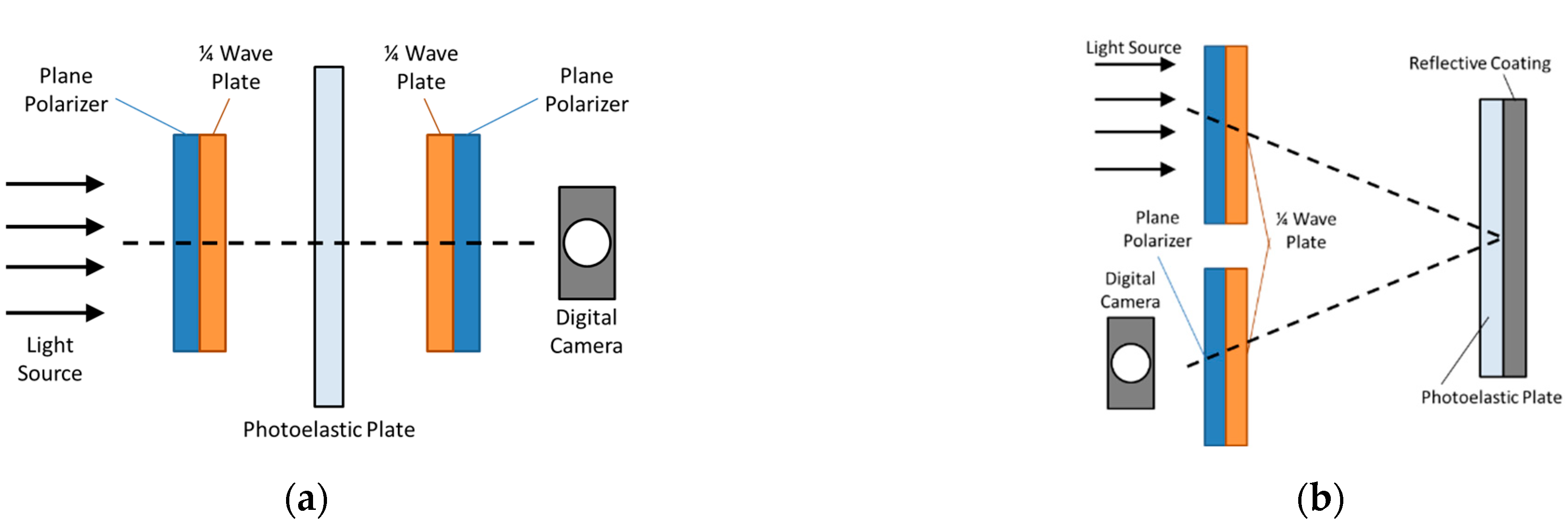
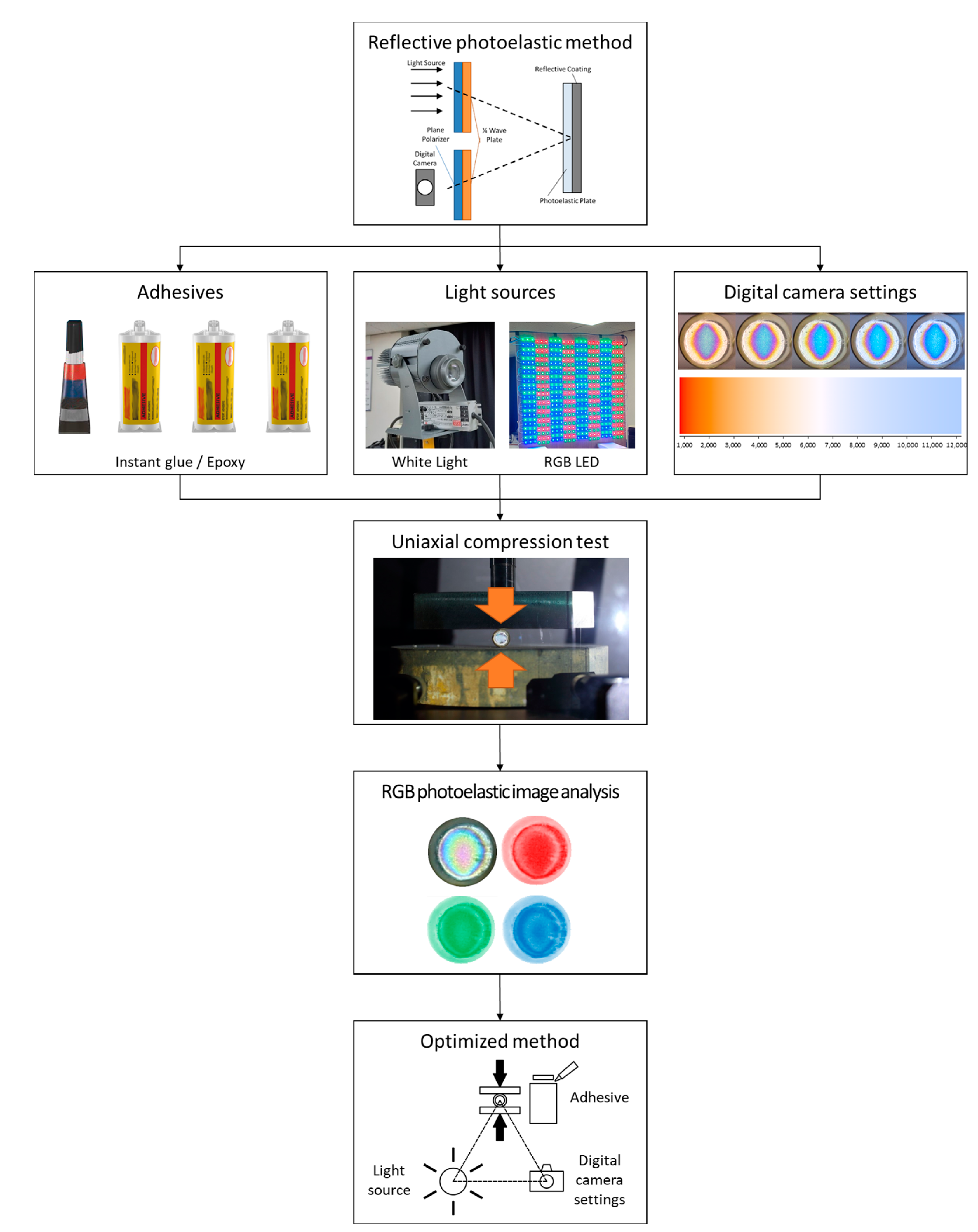
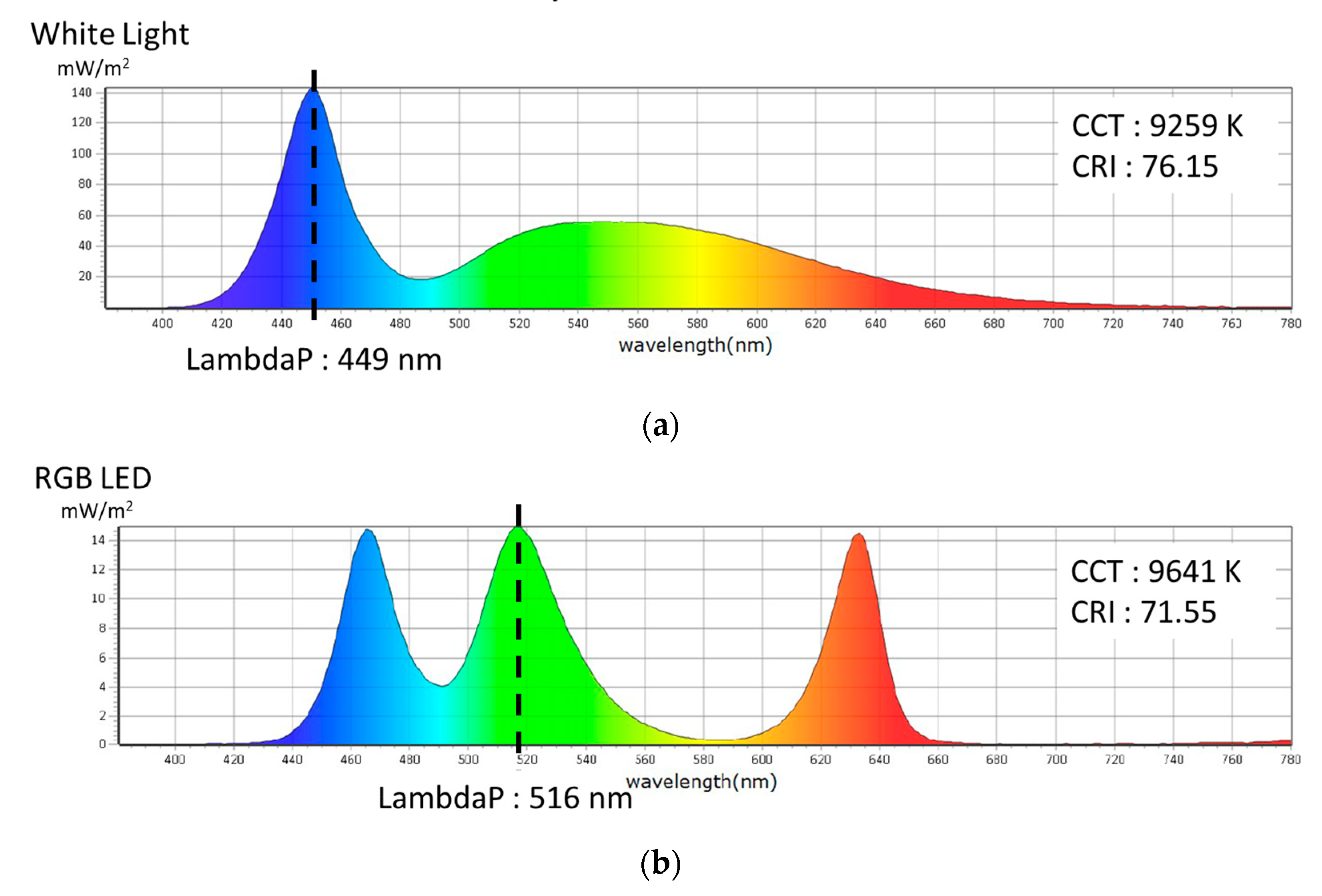

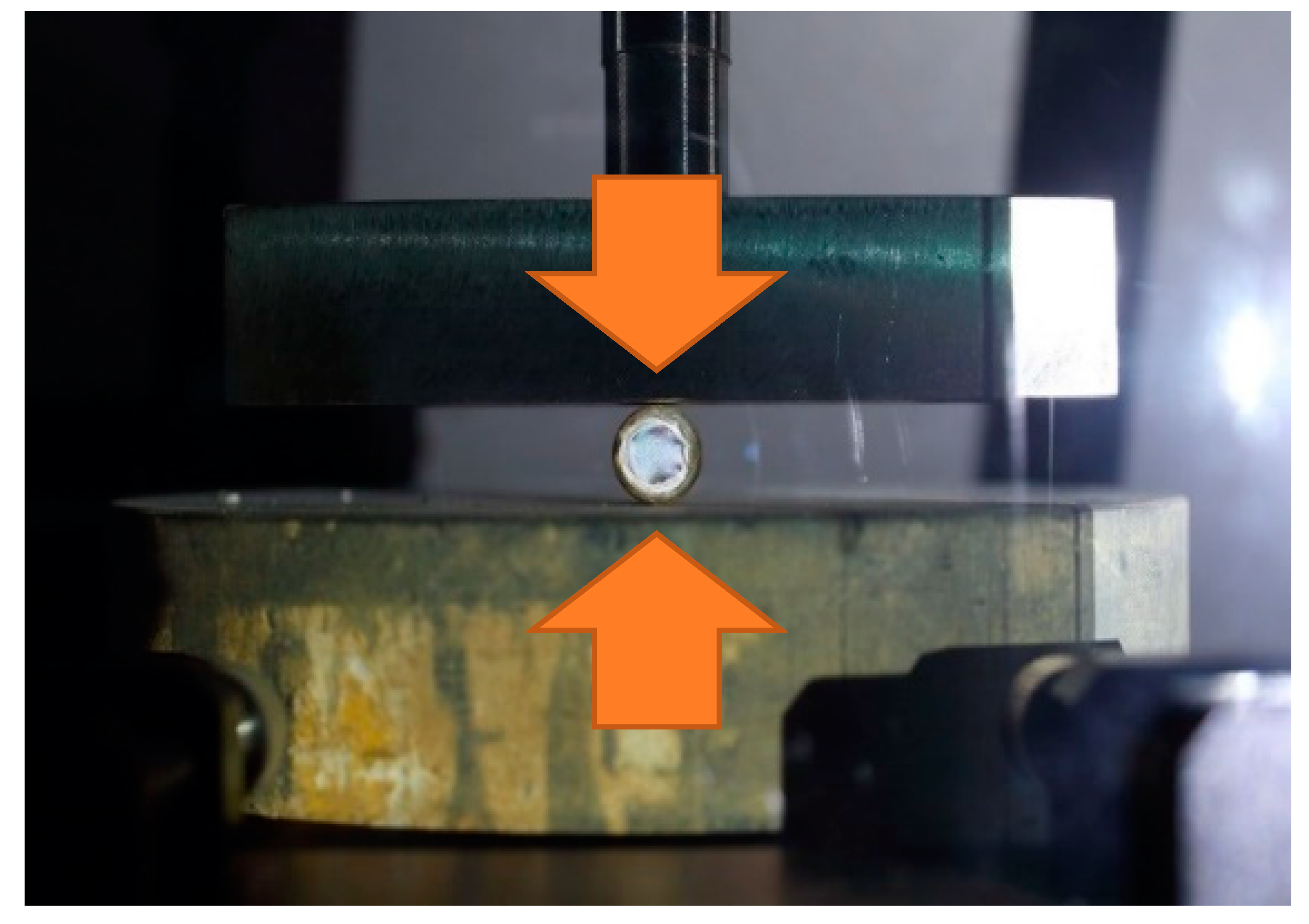

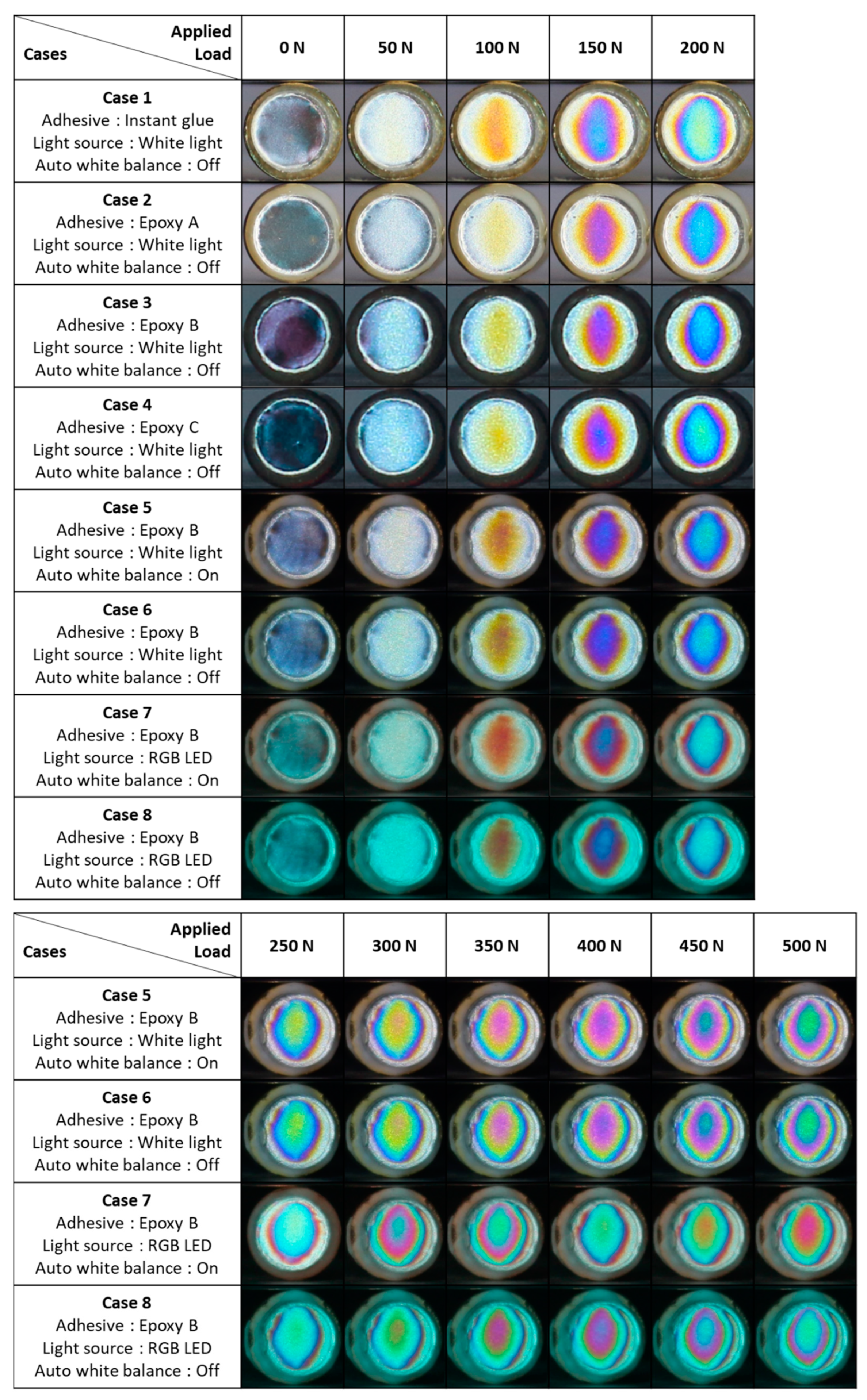
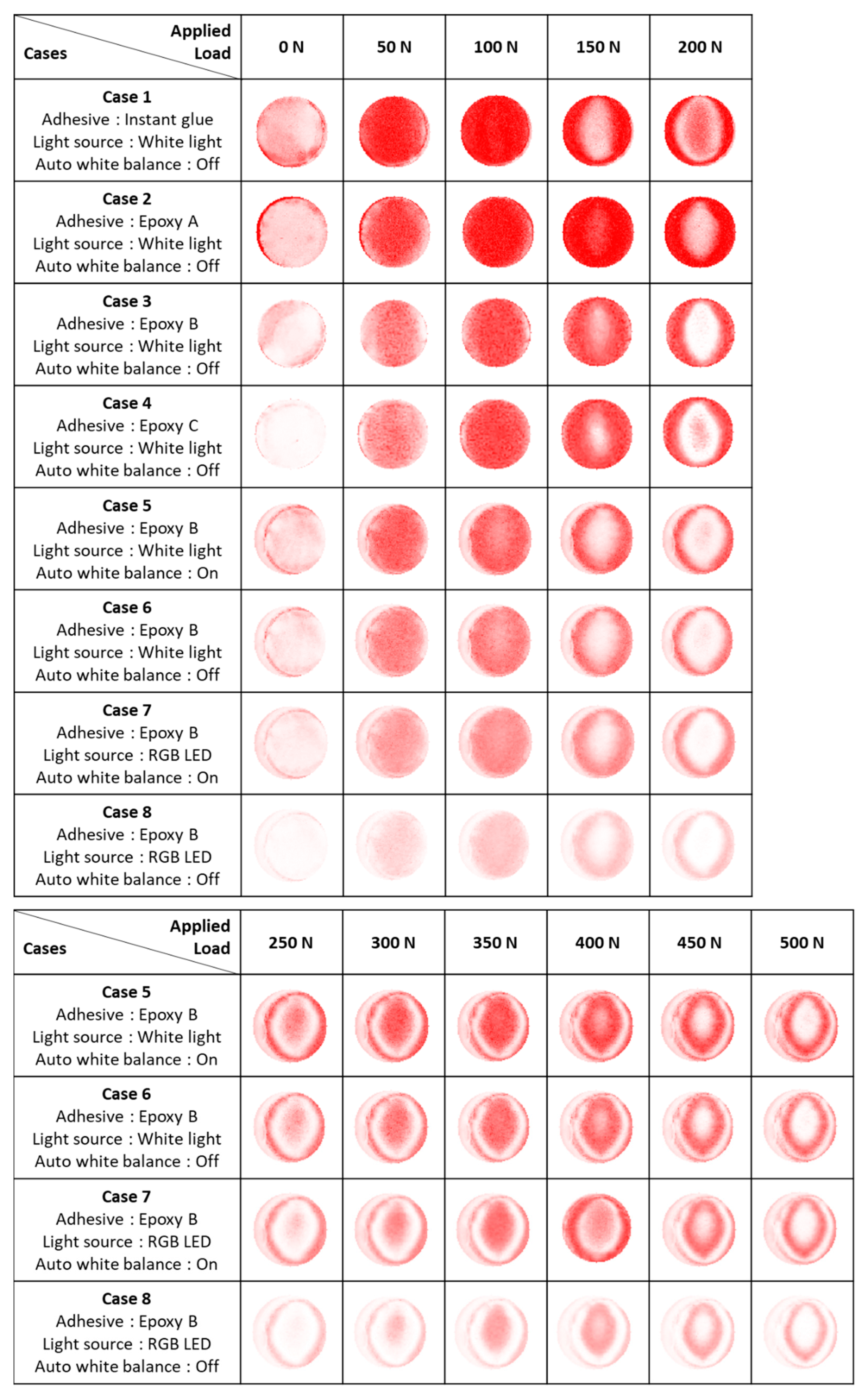
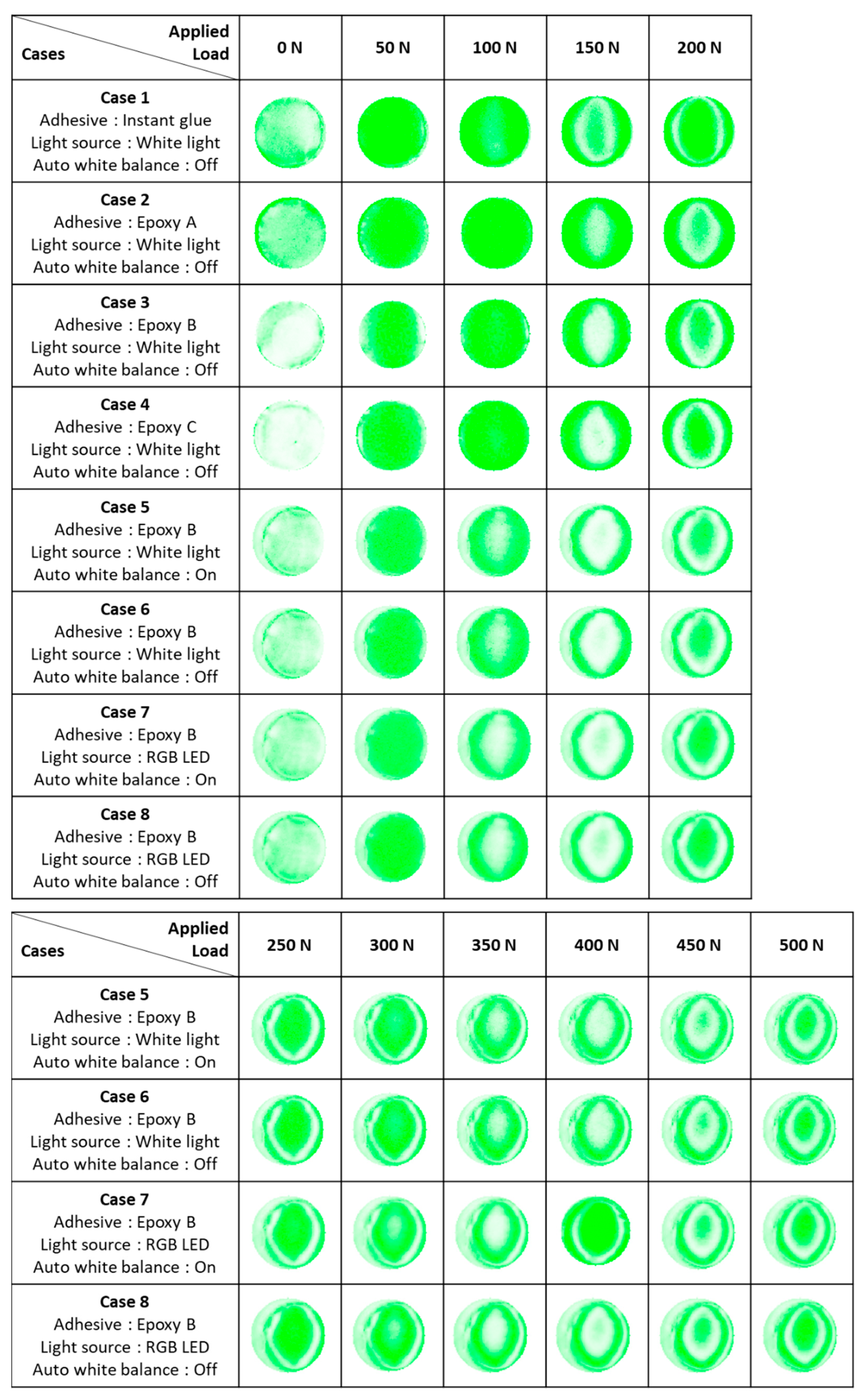
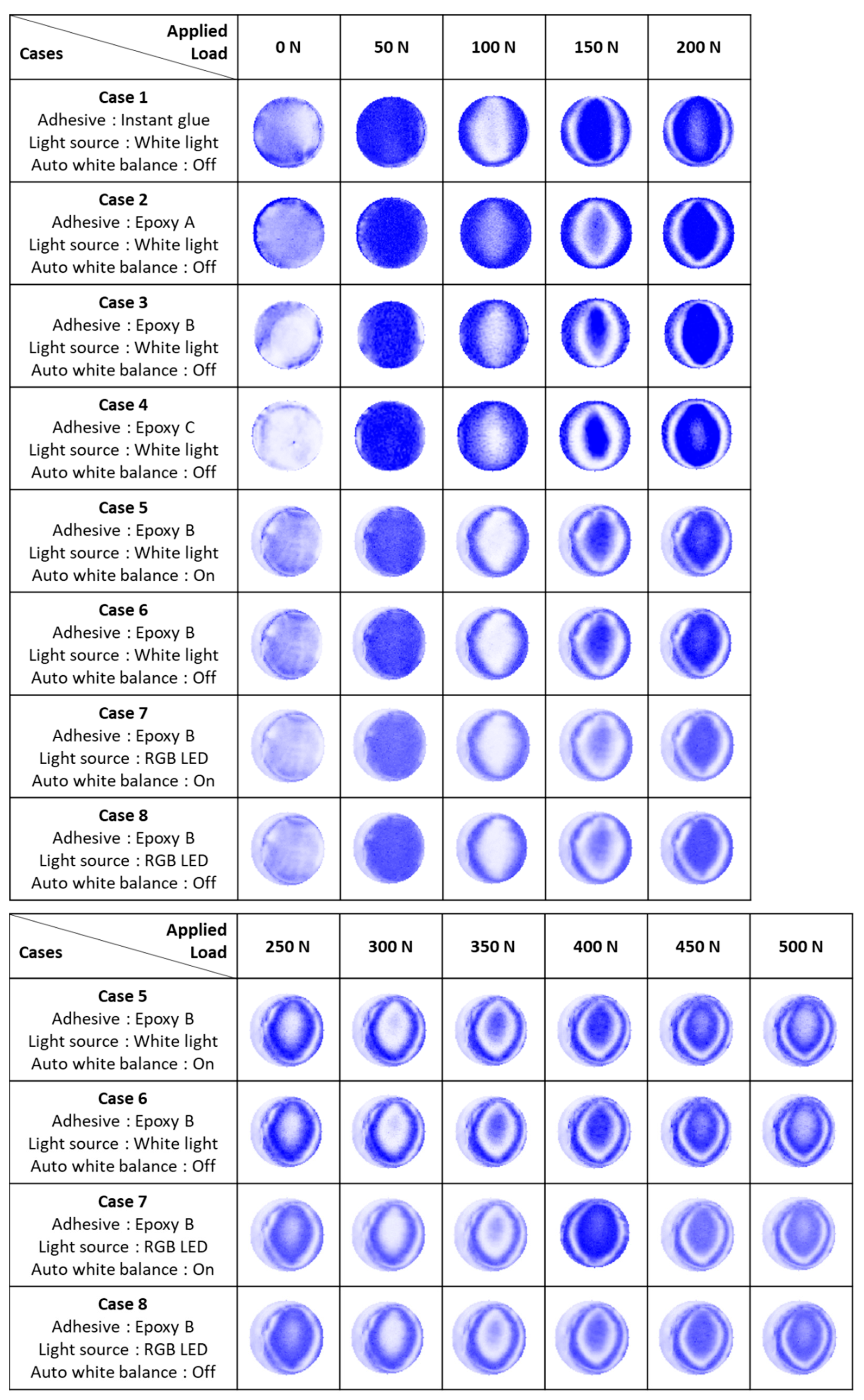
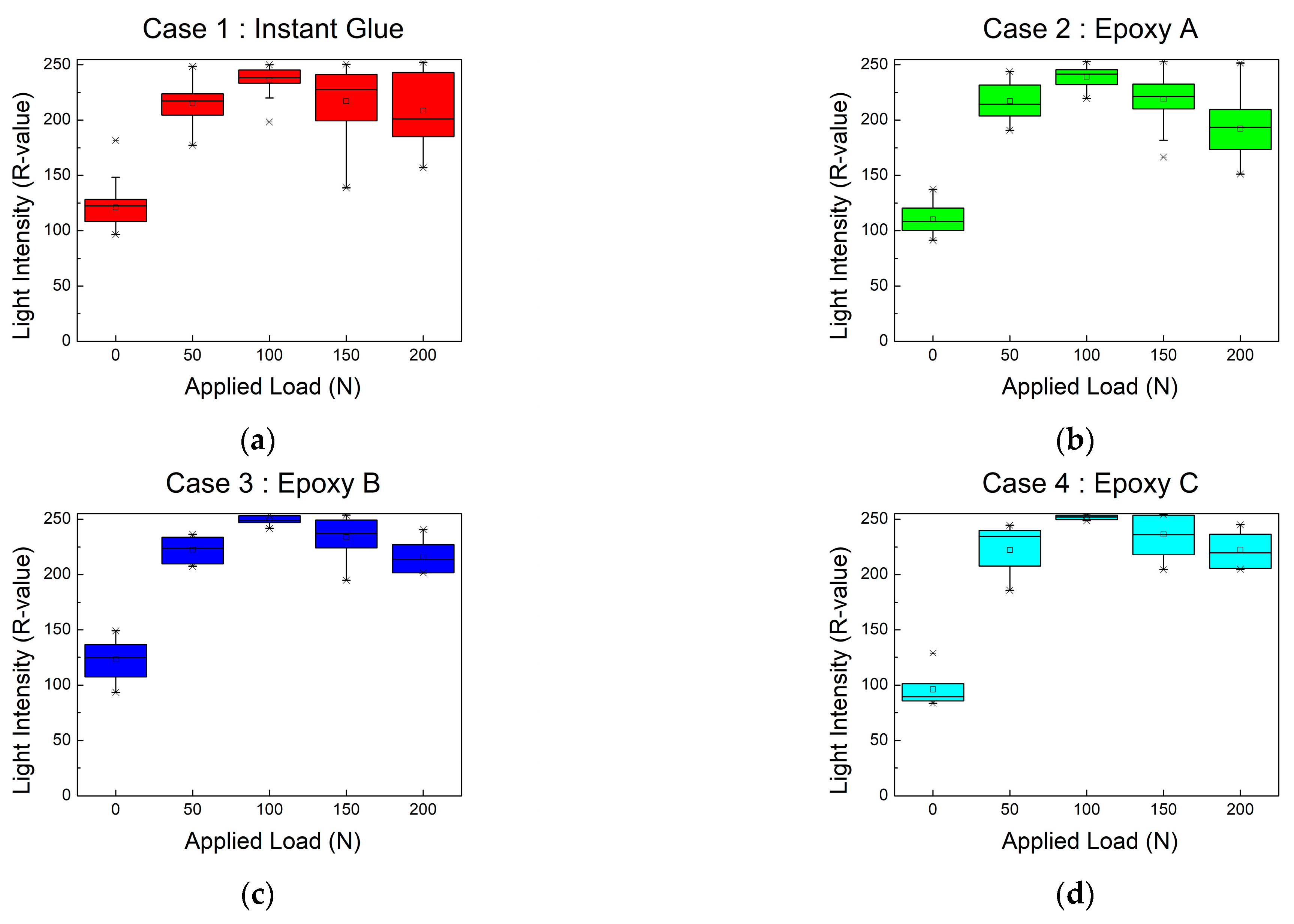
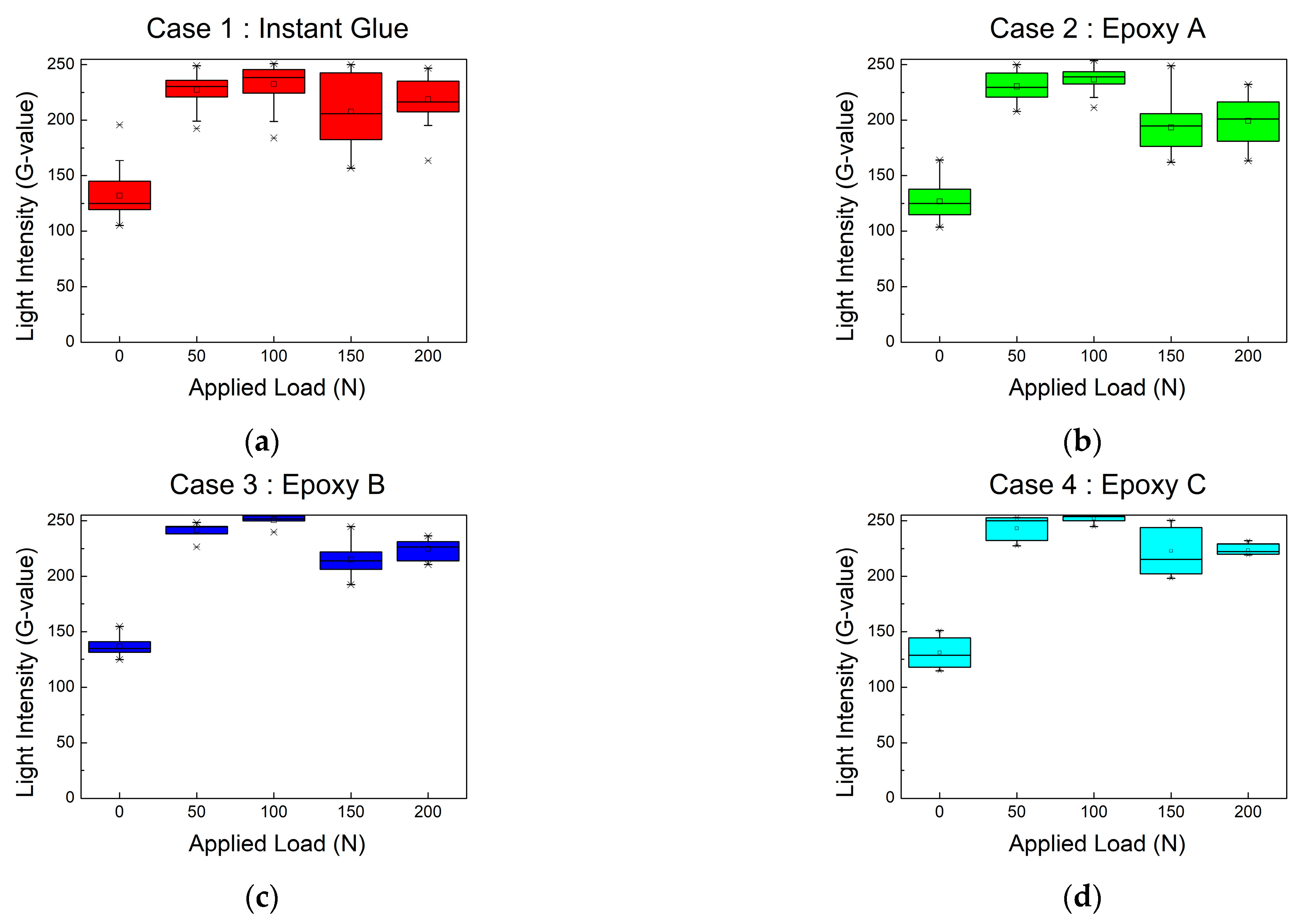



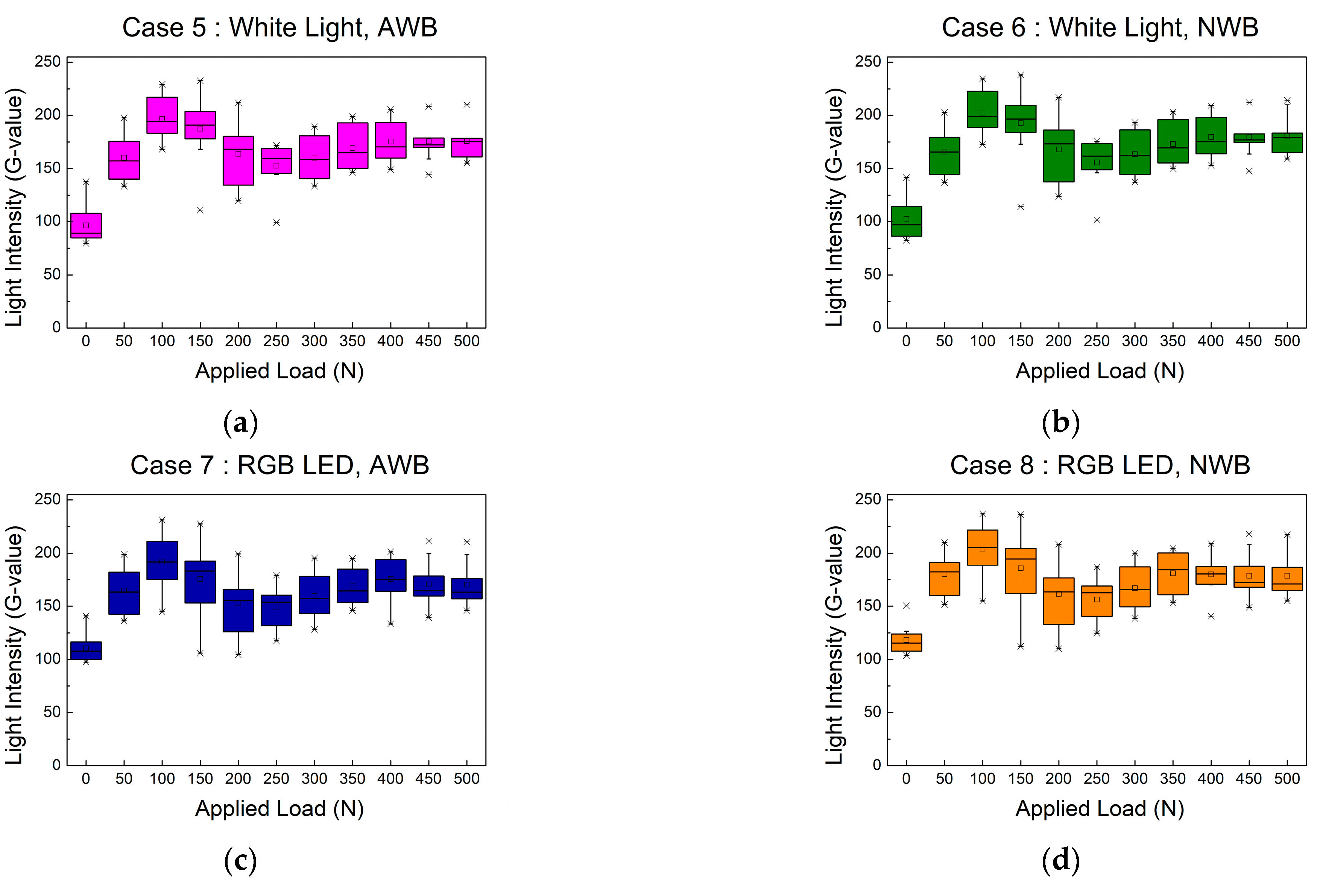




| Types | Tensile Strength (MPa) | Tensile Elongation (%) | Shear Strength (MPa) | Specific Gravity (g/L) | Viscosity (Pa.s) | |
|---|---|---|---|---|---|---|
| Resin | Hardener | |||||
| Instant glue | - | - | 15~25 | 1.10 | Non-drip gel | |
| Epoxy A | 39 | 8 | 22.6 | 1.03 | 40~90 | 5.5~8 |
| Epoxy B | 35 | 9 | 30 | 1.00 | 67.5 | 7 |
| Epoxy C | 41 | 10 | 30 | 1.10 | 41~61 | 2~4 |
| Model No. | Strain Optical Coefficient, | Elongation (%) | Elastic Modulus, (GPa) | Poisson’s Ratio | Thickness (mm) | Max Usable Temperature (°C) |
|---|---|---|---|---|---|---|
| PS-1 Sheet | 0.150 | 5 | 2.5 | 0.38 | 1(0.06) | 150 |
| Test Condition | Adhesives | Light Source | Auto White Balance |
|---|---|---|---|
| Case 1 | Instant glue | White light | Off |
| Case 2 | Epoxy A | White light | Off |
| Case 3 | Epoxy B | White light | Off |
| Case 4 | Epoxy C | White light | Off |
| Case 5 | Epoxy B | White light | On |
| Case 6 | Epoxy B | White light | Off |
| Case 7 | Epoxy B | RGB LED | On |
| Case 8 | Epoxy B | RGB LED | Off |
Disclaimer/Publisher’s Note: The statements, opinions and data contained in all publications are solely those of the individual author(s) and contributor(s) and not of MDPI and/or the editor(s). MDPI and/or the editor(s) disclaim responsibility for any injury to people or property resulting from any ideas, methods, instructions or products referred to in the content. |
© 2023 by the authors. Licensee MDPI, Basel, Switzerland. This article is an open access article distributed under the terms and conditions of the Creative Commons Attribution (CC BY) license (https://creativecommons.org/licenses/by/4.0/).
Share and Cite
Kim, S.; Nam, B.-H.; Jung, Y.-H. Evaluating Variability in Reflective Photoelasticity: Focus on Adhesives, Light Sources, and Camera Setup. Appl. Sci. 2023, 13, 10628. https://doi.org/10.3390/app131910628
Kim S, Nam B-H, Jung Y-H. Evaluating Variability in Reflective Photoelasticity: Focus on Adhesives, Light Sources, and Camera Setup. Applied Sciences. 2023; 13(19):10628. https://doi.org/10.3390/app131910628
Chicago/Turabian StyleKim, Seongmin, Boo-Hyun Nam, and Young-Hoon Jung. 2023. "Evaluating Variability in Reflective Photoelasticity: Focus on Adhesives, Light Sources, and Camera Setup" Applied Sciences 13, no. 19: 10628. https://doi.org/10.3390/app131910628






